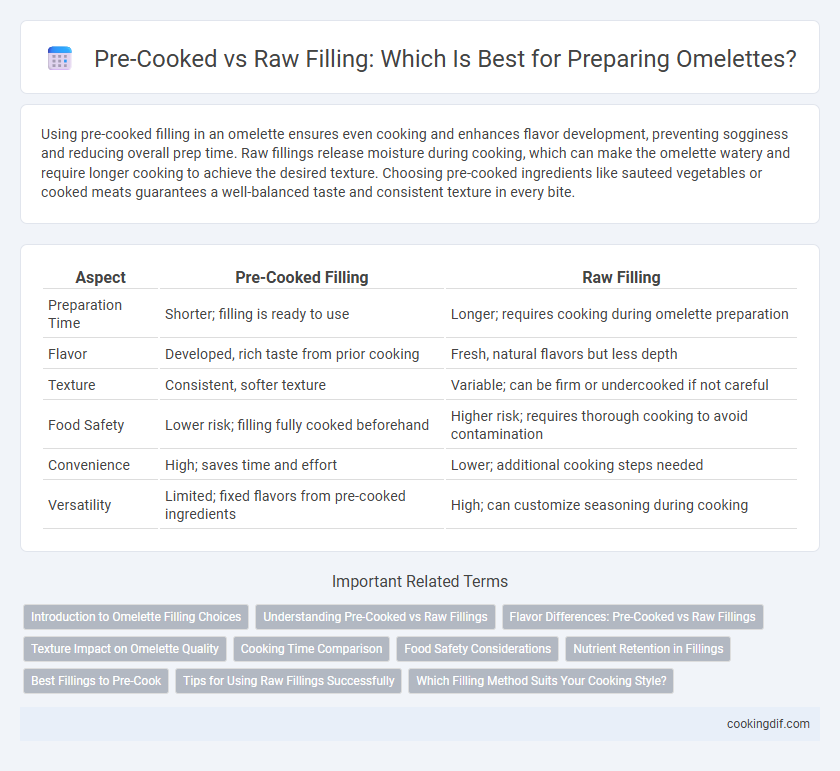Using pre-cooked filling in an omelette ensures even cooking and enhances flavor development, preventing sogginess and reducing overall prep time. Raw fillings release moisture during cooking, which can make the omelette watery and require longer cooking to achieve the desired texture. Choosing pre-cooked ingredients like sauteed vegetables or cooked meats guarantees a well-balanced taste and consistent texture in every bite.
Table of Comparison
| Aspect | Pre-Cooked Filling | Raw Filling |
|---|---|---|
| Preparation Time | Shorter; filling is ready to use | Longer; requires cooking during omelette preparation |
| Flavor | Developed, rich taste from prior cooking | Fresh, natural flavors but less depth |
| Texture | Consistent, softer texture | Variable; can be firm or undercooked if not careful |
| Food Safety | Lower risk; filling fully cooked beforehand | Higher risk; requires thorough cooking to avoid contamination |
| Convenience | High; saves time and effort | Lower; additional cooking steps needed |
| Versatility | Limited; fixed flavors from pre-cooked ingredients | High; can customize seasoning during cooking |
Introduction to Omelette Filling Choices
Omelette filling choices significantly impact flavor, texture, and cooking time, with pre-cooked fillings offering convenience and enhanced safety by reducing moisture content and ensuring even heating. Raw fillings, such as fresh vegetables or uncooked meats, provide fresher taste and nutritional benefits but require careful cooking to avoid undercooked ingredients and excess water release. Selecting the appropriate filling type depends on desired omelette consistency and preparation efficiency, balancing taste with optimal cooking methods.
Understanding Pre-Cooked vs Raw Fillings
Pre-cooked fillings in omelettes ensure even heat distribution and consistent texture, reducing the risk of undercooked ingredients and enhancing food safety. Raw fillings require careful cooking to integrate flavors but can result in uneven cooking and longer preparation times. Selecting pre-cooked fillings simplifies the cooking process and provides a uniform taste experience.
Flavor Differences: Pre-Cooked vs Raw Fillings
Pre-cooked fillings in omelettes develop deeper, more concentrated flavors through caramelization and browning, enhancing the overall taste profile. Raw fillings tend to release moisture during cooking, which can dilute the omelette's texture and flavor but preserve a fresher, more vibrant ingredient essence. Choosing between pre-cooked or raw fillings affects not only the flavor intensity but also the omelette's texture and visual appeal.
Texture Impact on Omelette Quality
Pre-cooked fillings retain moisture and develop a concentrated flavor, resulting in a tender, less watery omelette texture. Raw fillings release excess water during cooking, potentially making the omelette soggy and affecting its structural integrity. Choosing pre-cooked ingredients like sauteed vegetables or cooked meats ensures a consistent texture and enhances the overall quality of the omelette.
Cooking Time Comparison
Pre-cooked fillings in an omelette significantly reduce overall cooking time by requiring only reheating, allowing the egg to cook evenly without overcooking the filling. Raw fillings extend the cooking process as they must cook fully within the omelette, increasing risk of uneven texture or undercooked ingredients. Selecting pre-cooked fillings enhances efficiency and consistency, especially in high-volume or time-sensitive culinary environments.
Food Safety Considerations
Pre-cooked filling in omelette preparation reduces the risk of foodborne illnesses by eliminating pathogens before assembly, ensuring a safer meal. Raw fillings require thorough cooking within the omelette to reach safe internal temperatures and prevent bacterial contamination. Proper handling, storage, and hygiene are critical regardless of filling type to maintain overall food safety.
Nutrient Retention in Fillings
Pre-cooked fillings for omelettes often retain nutrients better due to reduced cooking time during final preparation, preserving heat-sensitive vitamins like vitamin C and B-complex. Raw fillings, while fresher, undergo direct heat exposure when cooked inside the omelette, which can lead to greater nutrient loss through oxidation and thermal degradation. Choosing pre-cooked fillings such as sauteed spinach or steamed mushrooms minimizes nutrient depletion and enhances overall nutrient bioavailability in the dish.
Best Fillings to Pre-Cook
Pre-cooked fillings such as sauteed mushrooms, caramelized onions, and roasted bell peppers enhance the flavor and texture of omelettes by reducing moisture and preventing sogginess. Using raw fillings like fresh tomatoes or spinach can release excess water during cooking, leading to a less structured omelette. Best fillings to pre-cook include diced bacon, ham, and potatoes, which ensure even heat distribution and a thoroughly cooked interior.
Tips for Using Raw Fillings Successfully
Using raw fillings in omelette preparation requires thorough chopping and even cooking to ensure all ingredients reach a safe internal temperature. Incorporate moisture-rich vegetables like tomatoes or bell peppers to enhance texture while minimizing sogginess by pre-sauteing or draining excess liquid. Season raw fillings adequately and allow the omelette to cook on low heat to balance softness and flavor integration without burning the eggs.
Which Filling Method Suits Your Cooking Style?
Pre-cooked filling for omelettes offers enhanced flavor development and consistent texture, ideal for cooks seeking precise control and quicker final assembly. Raw filling suits those who prefer fresher, lighter ingredients with natural moisture, enabling a softer, more tender omelette when cooked gently. Choosing between pre-cooked and raw fillings depends on your preference for flavor depth, cooking speed, and desired omelette texture.
Pre-cooked filling vs raw filling for preparation Infographic

 cookingdif.com
cookingdif.com